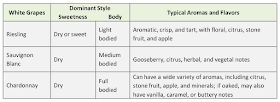In my Wine Tasting and Food Pairing 101 class, I’m often
asked this question, and it’s a good one.
It gets to the very heart of what wine is all about, and why it’s so
amazing. How is it possible that simple
fermented grape juice can produce so many wildly different tastes and styles?
There are 3 main factors:
1) Type of
Grape
Each type of grape has unique physical characteristics (such
as thickness of skin, acid content), growing requirements (amount of heat, sun,
water, and time needed to full ripen), and aromas/flavors (strawberries? black
current? lemons?).
Most of the wines in the world are made from what are known
as the international varieties. These
grapes have proven over hundreds of years that not only do they make excellent
wine, but they can grow in a variety of regions all around the world, and
retain certain signature qualities no matter where they are grown. International varieties include 3 reds (Pinot
Noir, Merlot, Cabernet Sauvignon) and 3 whites (Riesling, Sauvignon Blanc, and
Chardonnay). Sometimes other grapes are
included as well, but these are the big 6.
Though each of these grape varieties will express somewhat
different characteristics when grown in different places (as we’ll see in #2),
they will also retain key elements of their identity. For example, a Sauvignon Blanc, whether it’s
grown in France or New Zealand, will have its signature acidity and herbaceous
or vegetal quality. (Each of these 6
grapes will be profiled in detail in future posts.)
2) Climate/Region
Wine growing regions around the world are extremely
diverse. Some are chilly and rainy, like
the Bordeaux region of France or the state of Oregon. Some are hot and dry, like most of Australia,
or eastern Washington State. Some have
high altitude, like Mendoza in Argentina.
Some are hilly with steep slopes, like the Rhone Valley in France. Some are flat, like central Spain.
These international varieties of grapes have proven they can
grow in all kinds of places (though they each have their preferred conditions
in which they perform their best), but these different climates alter the final
product. Wine made from grapes grown in
a cooler climate tends to be lighter in body, higher in acid, lower in alcohol,
and more earthy than fruity in flavor.
Wine made from grapes grown in a warmer climate tends to be the opposite
– heavier in body, lower in acid, higher in alcohol, and richer in fruit
flavor.
To continue the Sauvignon Blanc example, if it comes from a
cooler region (such as Bordeaux), it will express more of its vegetal qualities
and high acid. If it comes from a warmer
region, such as California, it will express fewer vegetal aromas, its signature
gooseberry flavor will be more apparent, and it will be lower in acid.
3) Winemaker
Choices
During the fermentation process, the winemaker has many
choices to make which will determine the final character of the wine. Should it be sweet or dry? Still or sparkling? Oaked or unoaked? These decisions may be driven by the quality
of the grapes when they reach the winery, the preferences of the winery’s
customer base, or the winemaker’s own preferences.
Additionally, some winemaking regions allow the winemaker to
alter the sugar (or potential alcohol) levels and acid levels of the grapes,
though this is not done in the best regions or to the best wines.
Keep in mind that decisions made in the vineyard before
harvest time have already had a significant impact on the characteristics of
the grapes, before they even reach the winery.
We’ll talk about those in a future post.
Here’s a handy reference chart:
Copyright © 2012 by Joanna Opaskar
All rights reserved.












